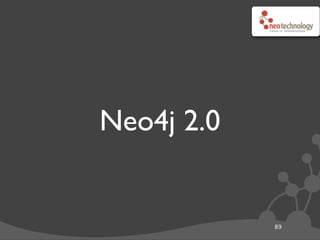Building Applications with a Graph Database
- 1. Building Applications with a Graph Database Tobias Lindaaker Software Developer @ Neo Technology twitter:! @thobe / @neo4j / #neo4j email:! [email protected] web:! http://neo4j.org/ web:! http://thobe.org/ CON6484
- 2. What you’ll face ๏Modeling your domain ๏Choosing your deployment model ๏Deploying and maintaining your application and DB ๏Evolving your application and your domain 2Most things are Surprisingly Familiar
- 3. Introducing the sample Application 3
- 4. Neo Technology Test Lab 4 ๏One-Stop place for QA •Real World cluster tests •Benchmarks •Charting •Statistics ‣Uses HdrHistogram http://giltene.github.io/HdrHistogram/ •Integrated Log analysis ‣GC logs and App logs ๏Click-and-go cluster deployment
- 5. Neo Technology Test Lab 5 ๏2 perpetual servers •1 database server (could be extended to a cluster for high availability) •1 “Test Lab Manager” ‣Manages clusters and test executions ‣Serves up the UI ๏Data-centric HTTP API ๏UI in pure javascript, static files, client-side rendering
- 6. Neo Technology Test Lab 6 ๏All state in DB, allows for multiple Manager instances, greatly simplifies redeploy: 1. Start new instance for the new manager 2. Verify that the new manager works properly 3. Re-bind elastic IP to new instance 4. Terminate old instance ๏No downtime on redeploy
- 7. Neo Technology Test Lab 7 ๏Cute but useful: Single click to SSH into a cluster server in the browser ๏VT100 emulator in JavaScript ๏Uses com.jcraft:jsch to let the manager connect to the server •(only) the manager has the private key to the servers ๏Tunnel terminal connection through WebSocket ๏Really useful for introspection Why did installation fail?
- 8. Analysis of requirements ๏UI for reporting and overview of activity ๏Easy to use & Easy to extend ๏API for triggering real world cluster tests from the CI system ๏Eat our own dog food •Use Neo4j for storage needs •Use our Cloud hosting solution ๏Make costs visible ๏Strong desire not to own hardware 8
- 9. Data storage/retrieval requirements ๏Store all meta-data about tests and their outcome •The actual result data can be raw files ๏All entities can have arbitrary events attached these should always be fetched, used to determine state of the entity ๏Minimize the number of round-trips made to the database Each action should preferably be only one DB call 9
- 11. An overview of Cypher 11 ๏START - the node(s) your query starts from - Not needed in Neo4j 2.0 ๏MATCH - the pattern to follow from the start point(s) this expands your search space ๏WHERE - filter instances of the pattern this reduces your search space ๏RETURN - create a result projection of each matching instance of the pattern ๏Patterns are described using ASCII-art •(me)-[:FRIEND]-()-[:FRIEND]-(my_foaf) (me)-[:LIKES]->()<-[:LIKES]-(foaf) // find friends of my friends that share an interest with me The basics in one slide
- 12. An overview of Cypher 12 ๏CREATE - create nodes and relationships based on a pattern ๏SET - assign properties to nodes and relationships ๏DELETE - delete nodes or relationships ๏CREATE UNIQUE - as CREATE, but only if no match is found •being superseded by MERGE in Neo4j 2.0 ๏FOREACH - perform update operation for each item in a collection Creates and Updates
- 13. Some more advanced Cypher ๏WITH - start a sub-query, carrying over only the declared variables Similar format to return, allows the same kinds of projections ๏ORDER BY - sort the matching pattern instances by a property Used in WITH or RETURN. ๏SKIP and LIMIT - page through results, used with ORDER BY. ๏Aggregation •COLLECT - turn a part of a pattern instance into a collection of that part for each matching pattern instance Comparable to SQLs GROUP BY. •SUM - summarize an expression for each match (like in SQL) •AVG, MIN, MAX, and COUNT - as in SQL 13
- 15. Domain modeling guideline 15 ๏Query first ๏Whiteboard first ๏Examples first ๏Redundancy - avoid ๏Thank You Look at the top left of your keyboard!
- 16. Query First 16 ๏Create the model to satisfy your queries ๏Do not attempt to mirror the real world •You might do that, but it is not a goal in itself ๏Start by writing down the queries you need to satisfy •Write using natural language •Then analyze and formalize ๏Now you are ready to draw the model...
- 18. Example first 18 ๏Draw one or more examples of entities in your domain ๏Do not leap straight to UML or other archetypical models ๏Once you have a few examples you can draw the model (unless it is already clear from the examples)
- 19. Redundancy - avoid 19 ๏Relationships are bi-directional, avoid creating “inverse” relationships ๏Don’t connect each node of a certain “type” to some node that represents that type •Leads to unnecessary bottle necks •Use the path you reached a node through to know its type •Use labels to find start points ‣and for deciding type dynamically if multiple are possible ๏Avoid materializing information that can be inferred •Don’t add FRIEND_OF_A_FRIEND relationships, when you have FRIEND relationships
- 21. Method 1. Identify application/end-user goals 2. Figure out what questions to ask of the domain 3. Identify entities in each question 4. Identify relationships between entities in each question 5. Convert entities and relationships to paths - These become the basis of the data model 6. Express questions as graph patterns - These become the basis for queries 21 Thanks to Ian Robinson
- 22. 1.Application/End-User Goals 22 As an employee I want to know who in thecompany has similar skills tome So that we can exchangeknowledge Thanks to Ian Robinson
- 23. 2. Questions to ask of the Domain 23 Which people, who work for the same company as me, have similar skills to me? As an employee I want to know who in thecompany has similar skills tome So that we can exchangeknowledge Thanks to Ian Robinson
- 24. 3. Identify Entities 24 Which people, who work for the same company as me, have similar skills to me? •Person •Company •Skill Thanks to Ian Robinson
- 25. 4. Identify Relationships Between Entities 25 Which people, who work for the same company as me, have similar skills to me? •Person WORKS FOR Company •Person HAS SKILL Skill Thanks to Ian Robinson
- 26. 5. Convert to Cypher Paths 26 •Person WORKS FOR Company •Person HAS SKILL Skill Thanks to Ian Robinson
- 27. 5. Convert to Cypher Paths 26 •Person WORKS FOR Company •Person HAS SKILL Skill NodeNode Node Node Thanks to Ian Robinson
- 28. 5. Convert to Cypher Paths 26 •Person WORKS FOR Company •Person HAS SKILL Skill Relationship NodeNode Relationship Node Node Thanks to Ian Robinson
- 29. 5. Convert to Cypher Paths 26 •Person WORKS FOR Company •Person HAS SKILL Skill (:Person)-[:WORKS_FOR]->(:Company), (:Person)-[:HAS_SKILL]->(:Skill) Relationship NodeNode Relationship Node Node Thanks to Ian Robinson
- 30. 5. Convert to Cypher Paths 26 •Person WORKS FOR Company •Person HAS SKILL Skill (:Person)-[:WORKS_FOR]->(:Company), (:Person)-[:HAS_SKILL]->(:Skill) Relationship NodeNode Relationship Node Node Label Label Label Label Thanks to Ian Robinson
- 31. 5. Convert to Cypher Paths 26 •Person WORKS FOR Company •Person HAS SKILL Skill (:Person)-[:WORKS_FOR]->(:Company), (:Person)-[:HAS_SKILL]->(:Skill) Relationship NodeNode Relationship Node Node Label Label Label Label Relationship Type Relationship Type Thanks to Ian Robinson
- 32. Consolidate Pattern (:Person)-[:WORKS_FOR]->(:Company), (:Person)-[:HAS_SKILL]->(:Skill) (:Company)<-[:WORKS_FOR]-(:Person)-[:HAS_SKILL]->(:Skill) 27 Person SkillCompany WORKS_FOR HAS_SKILL Thanks to Ian Robinson
- 33. Candidate Data Model (:Company)<-[:WORKS_FOR]-(:Person)-[:HAS_SKILL]->(:Skill) 28 name: Neo4j name: Ian name: ACME Person Company WORKS_FOR HAS_SKILL name: Jacob Person name: Tobias Person W O RKS_FO R W O RKS_FO R name: Scala name: Python name: C# SkillSkillSkillSkill HAS_SKILL HAS_SKILLHAS_SKILL HAS_SKILL HAS_SKILL HAS_SKILL Thanks to Ian Robinson
- 34. 6. Express Question as Graph Pattern Which people, who work for the same company as me, have similar skills to me? 29 skill company Company colleagueme Person W O RKS_FO R W O RKS_FO R Skill HAS_SKILL HAS_SKILL Person Thanks to Ian Robinson
- 35. Cypher Query Which people, who work for the same company as me, have similar skills to me? MATCH (company)<-[:WORKS_FOR]-(me:Person)-[:HAS_SKILL]->(skill) (company)<-[:WORKS_FOR]-(colleague)-[:HAS_SKILL]->(skill) WHERE me.name = {name} RETURN colleague.name AS name, count(skill) AS score, collect(skill.name) AS skills ORDER BY score DESC 30 skill company Company colleagueme Person W O RKS_FO R W O RKS_FO R Skill HAS_SKILL HAS_SKILL Person Thanks to Ian Robinson
- 36. Cypher Query Which people, who work for the same company as me, have similar skills to me? MATCH (company)<-[:WORKS_FOR]-(me:Person)-[:HAS_SKILL]->(skill) (company)<-[:WORKS_FOR]-(colleague)-[:HAS_SKILL]->(skill) WHERE me.name = {name} RETURN colleague.name AS name, count(skill) AS score, collect(skill.name) AS skills ORDER BY score DESC 31 skill company Company colleagueme Person W O RKS_FO R W O RKS_FO R Skill HAS_SKILL HAS_SKILL Person 1. Graph pattern
- 37. Cypher Query Which people, who work for the same company as me, have similar skills to me? MATCH (company)<-[:WORKS_FOR]-(me:Person)-[:HAS_SKILL]->(skill) (company)<-[:WORKS_FOR]-(colleague)-[:HAS_SKILL]->(skill) WHERE me.name = {name} RETURN colleague.name AS name, count(skill) AS score, collect(skill.name) AS skills ORDER BY score DESC 32 skill company Company colleagueme Person W O RKS_FO R W O RKS_FO R Skill HAS_SKILL HAS_SKILL Person 1. Graph pattern 2. Filter, using index if available
- 38. Cypher Query Which people, who work for the same company as me, have similar skills to me? MATCH (company)<-[:WORKS_FOR]-(me:Person)-[:HAS_SKILL]->(skill) (company)<-[:WORKS_FOR]-(colleague)-[:HAS_SKILL]->(skill) WHERE me.name = {name} RETURN colleague.name AS name, count(skill) AS score, collect(skill.name) AS skills ORDER BY score DESC 33 skill company Company colleagueme Person W O RKS_FO R W O RKS_FO R Skill HAS_SKILL HAS_SKILL Person 1. Graph pattern 2. Filter, using index if available 3. Create projection of result
- 42. Result of the Query +-------------------------------------+ | name | score | skills | +-------------------------------------+ | "Ian" | 2 | ["Scala","Neo4j"] | | "Jacob" | 1 | ["Neo4j"] | +-------------------------------------+ 2 rows 37 Thanks to Ian Robinson
- 44. Ordered List of Entities 39 ๏When •Entities have a natural succession •You need to traverse the sequence ๏You may need to identify the beginning or end (first/last, earliest/latest, etc.) ๏Examples •Event stream •Episodes of a TV series •Job history Thanks to Ian Robinson
- 45. Example: Episodes in Doctor Who 40 title: Robot title: The Ark in Space title:The Sontaran Experiment title: Genesis of the Daleks title: Revenge of the Cybermen NEXT NEXT NEXT NEXT NEXT NEXT NEXT IN PRODUCTION Thanks to Ian Robinson
- 46. Example: Episodes in Doctor Who 40 title: Robot title: The Ark in Space title:The Sontaran Experiment title: Genesis of the Daleks title: Revenge of the Cybermen NEXT NEXT NEXT NEXT NEXT NEXT NEXT IN PRODUCTION NEXT IN PRODUCTION NEXT IN PRODUCTION NEXT IN PRODUCTION NEXT IN PRODUCTION ๏Can interleave multiple lists with different semantics Using different relationship types Thanks to Ian Robinson
- 47. Example: Episodes in Doctor Who 40 title: Robot title: The Ark in Space title:The Sontaran Experiment title: Genesis of the Daleks title: Revenge of the Cybermen NEXT NEXT NEXT NEXT NEXT NEXT NEXT IN PRODUCTION season: 12 NEXT IN PRODUCTION NEXT IN PRODUCTION NEXT IN PRODUCTION NEXT IN PRODUCTION LAST FIRST ๏Can interleave multiple lists with different semantics Using different relationship types ๏Can organize lists into groups by group nodes season: 11 NEXT SEASON Thanks to Ian Robinson
- 49. Add to list 42 MATCH (test:Test{testId:{testId}}) MERGE (recents:Recent{type:"Test"}) CREATE (recents)-[:LAST_COMPLETED_TEST]->(test) WITH recents, test MATCH (recents)-[:LAST_COMPLETED_TEST]-> (test), (previousTest)<-[previous:LAST_COMPLETED_TEST]-(recents) DELETE previous CREATE (test)-[:PREVIOUS_COMPLETED_TEST]->(previousTest)
- 50. Add to list 43 MATCH (test:Test{testId:{testId}}) MERGE (recents:Recent{type:"Test"}) CREATE (recents)-[:LAST_COMPLETED_TEST]->(test) WITH recents, test MATCH (recents)-[:LAST_COMPLETED_TEST]-> (test), (previousTest)<-[previous:LAST_COMPLETED_TEST]-(recents) DELETE previous CREATE (test)-[:PREVIOUS_COMPLETED_TEST]->(previousTest) // create the structure we want for the most recent one MATCH (test:Test{testId:{testId}}) MERGE (recents:Recent{type:"Test"}) CREATE (recents)-[:LAST_COMPLETED_TEST]->(test)
- 51. Add to list 44 // create the structure we want for the most recent one MATCH (test:Test{testId:{testId}}) MERGE (recents:Recent{type:"Test"}) CREATE (recents)-[:LAST_COMPLETED_TEST]->(test) WITH recents, test MATCH (recents)-[:LAST_COMPLETED_TEST]-> (test), (previousTest)<-[previous:LAST_COMPLETED_TEST]-(recents) DELETE previous CREATE (test)-[:PREVIOUS_COMPLETED_TEST]->(previousTest) // start a new sub-query, carrying through ‘recents’ and ‘test’ WITH recents, test
- 52. Add to list 45 // create the structure we want for the most recent one MATCH (test:Test{testId:{testId}}) MERGE (recents:Recent{type:"Test"}) CREATE (recents)-[:LAST_COMPLETED_TEST]->(test) // start a new sub-query, carrying through ‘recents’ and ‘test’ WITH recents, test MATCH (recents)-[:LAST_COMPLETED_TEST]-> (test), (previousTest)<-[previous:LAST_COMPLETED_TEST]-(recents) DELETE previous CREATE (test)-[:PREVIOUS_COMPLETED_TEST]->(previousTest) // matching the relationship we just created... MATCH (recents)-[:LAST_COMPLETED_TEST]-> (test), // ...ensures that ‘previous’ is a different relationship (previousTest)<-[previous:LAST_COMPLETED_TEST]-(recents) // if there was no previous, this sub-query will match nothing
- 53. Add to list 46 // create the structure we want for the most recent one MATCH (test:Test{testId:{testId}}) MERGE (recents:Recent{type:"Test"}) CREATE (recents)-[:LAST_COMPLETED_TEST]->(test) // start a new sub-query, carrying through ‘recents’ and ‘test’ WITH recents, test // matching the relationship we just created... MATCH (recents)-[:LAST_COMPLETED_TEST]-> (test), // ...ensures that ‘previous’ is a different relationship (previousTest)<-[previous:LAST_COMPLETED_TEST]-(recents) // if there was no previous, this sub-query will match nothing DELETE previous CREATE (test)-[:PREVIOUS_COMPLETED_TEST]->(previousTest) // re-link to the previousTest DELETE previous CREATE (test)-[:PREVIOUS_COMPLETED_TEST]->(previousTest)
- 54. Add to list 47 // create the structure we want for the most recent one MATCH (test:Test{testId:{testId}}) MERGE (recents:Recent{type:"Test"}) CREATE (recents)-[:LAST_COMPLETED_TEST]->(test) // start a new sub-query, carrying through ‘recents’ and ‘test’ WITH recents, test // matching the relationship we just created... MATCH (recents)-[:LAST_COMPLETED_TEST]-> (test), // ...ensures that ‘previous’ is a different relationship (previousTest)<-[previous:LAST_COMPLETED_TEST]-(recents) // if there was no previous, this sub-query will match nothing // re-link to the previousTest DELETE previous CREATE (test)-[:PREVIOUS_COMPLETED_TEST]->(previousTest)
- 55. Get 5 most recently completed tests MATCH (recents:Recent{type:"Test"}), (recents)-[:LAST_COMPLETED_TEST]->(last) tests=(last)-[:PREVIOUS_COMPLETED_TEST*0..5]->() WITH tests ORDER BY length(tests) DESC LIMIT 1 RETURN extract(test IN nodes(tests) : test.testId) AS testIds 48
- 56. Get 5 most recently completed tests MATCH (recents:Recent{type:"Test"}), (recents)-[:LAST_COMPLETED_TEST]->(last) tests=(last)-[:PREVIOUS_COMPLETED_TEST*0..5]->() WITH tests ORDER BY length(tests) DESC LIMIT 1 RETURN extract(test IN nodes(tests) : test.testId) AS testIds 48 Get the next page of 5 MATCH (last:Test{testId={testId}}) tests=(last)-[:PREVIOUS_COMPLETED_TEST*0..5]->() WITH tests ORDER BY length(tests) DESC LIMIT 1 RETURN extract(test IN nodes(tests) : test.testId) AS testIds
- 58. Adding and Removing from Active Set 50 // Create cluster into active set MATCH (clusters:ActiveSet{type:"Cluster"}), (creator:User{userId:{userId}}) CREATE (clusters)-[:CLUSTER]->(cluster:Cluster{ clusterId: {clusterId}, clusterType: {clusterType} }), (cluster)-[:CREATED]->(:Event{timestamp:{creationDate}}) <-[:ACTION]-(creator) // Destroy cluster (remove it from the active set) MATCH (cluster:Cluster{clusterId:{clusterId}})<-[r:CLUSTER]-(), (destroyer:User{userId:{userId}}) CREATE (cluster)-[:DESTROYED]->(:Event{timestamp:{destroyDate}}) <-[:ACTION]-(destroyer) DELETE r
- 59. Entities and Events/Actions 51 ๏Events/Actions often involve multiple parties •Eg. the actor that caused the event, and the affected entity ๏Can include other circumstantial detail, which may be common to multiple events ๏Examples: •Patrick worked for Acme from 2001 to 2005 as a Software Developer •Sarah sent an email to Lucy, copying in David and Claire ๏In environments with concurrent updates, events can be used to compute state •No need to explicitly store state Thanks to Ian Robinson
- 60. Represent the Event/Action as a Node 52 name: Patrick from: 2001 to: 2005 title: Software Developer name: Acme EMPLOYMENT ROLE COMPANY name: Sarah subject: ... content: ... name: Lucy name: Sarah name: Sarah FROM TO CC CC Thanks to Ian Robinson
- 61. Using Events to compute State 53 ๏Every update of an entity adds an event to it ๏Every read query collects up all events for the entity ๏Entity state is computed in your (Java) code from the events public class Cluster { private final List<ClusterEvent> events; public ClusterState getState() { ClusterState state = ClusterState.AWAITING_LAUNCH; for ( ClusterEvent event : events ) { ClusterState candidate = event.impliedState(); if ( candidate.comparedTo( state ) > 0 ) state = candidate; } return state; } // ... }
- 62. Repository pattern 54 ๏Centralize your queries into one or a few places ๏Puts load logic (with translation from DB layer to App layer) next to store logic (with the reverse transformation logic) ๏Simplifies testing •If you use Java, test with Embedded Neo4j. Interact through Cypher (for the code under test) Verify using the object graph API ๏Simplifies model evolution - load/store & conversion encapsulated
- 63. Find all active clusters - Neo4j 2.0 MATCH (clusters:ActiveSet{type:"Cluster"}) (clusters)-[:CLUSTER]->(cluster), (server)-[?:MEMBER_OF]->(cluster), (server)-[e]->(event:Event), (event)-[?]->(details) WITH cluster, server, e, event, collect(details) as eventDetails WITH cluster, server, collect({ type: type(e), data: event, details: eventDetails }) as serverEvents WITH cluster, collect({ server: server, events: serverEvents }) as servers MATCH (cluster)-[?:PARAMETERS]->(parameters), (cluster)-[e]->(event:Event)<-[:ACTION]-(actor) RETURN cluster, serverNodeIds, parameters, collect({ type: type(e), data: event, actor: actor} ) as events 55
- 64. Find all active clusters - Neo4j 2.0 MATCH (clusters:ActiveSet{type:"Cluster"}) (clusters)-[:CLUSTER]->(cluster), (server)-[?:MEMBER_OF]->(cluster), (server)-[e]->(event:Event), (event)-[?]->(details) WITH cluster, server, e, event, collect(details) as eventDetails WITH cluster, server, collect({ type: type(e), data: event, details: eventDetails }) as serverEvents WITH cluster, collect({ server: server, events: serverEvents }) as servers MATCH (cluster)-[?:PARAMETERS]->(parameters), (cluster)-[e]->(event:Event)<-[:ACTION]-(actor) RETURN cluster, serverNodeIds, parameters, collect({ type: type(e), data: event, actor: actor} ) as events 56 MATCH (clusters:ActiveSet{type:"Cluster"}) (clusters)-[:CLUSTER]->(cluster), // each active cluster
- 65. Find all active clusters - Neo4j 2.0 MATCH (clusters:ActiveSet{type:"Cluster"}) (clusters)-[:CLUSTER]->(cluster), (server)-[?:MEMBER_OF]->(cluster), (server)-[e]->(event:Event), (event)-[?]->(details) WITH cluster, server, e, event, collect(details) as eventDetails WITH cluster, server, collect({ type: type(e), data: event, details: eventDetails }) as serverEvents WITH cluster, collect({ server: server, events: serverEvents }) as servers MATCH (cluster)-[?:PARAMETERS]->(parameters), (cluster)-[e]->(event:Event)<-[:ACTION]-(actor) RETURN cluster, serverNodeIds, parameters, collect({ type: type(e), data: event, actor: actor} ) as events 57 (server)-[?:MEMBER_OF]->(cluster),// 0 or more servers (server)-[e]->(event:Event),// any relationship to an Event (event)-[?]->(details)// 0 or more details
- 66. Find all active clusters - Neo4j 2.0 MATCH (clusters:ActiveSet{type:"Cluster"}) (clusters)-[:CLUSTER]->(cluster), (server)-[?:MEMBER_OF]->(cluster), (server)-[e]->(event:Event), (event)-[?]->(details) WITH cluster, server, e, event, collect(details) as eventDetails WITH cluster, server, collect({ type: type(e), data: event, details: eventDetails }) as serverEvents WITH cluster, collect({ server: server, events: serverEvents }) as servers MATCH (cluster)-[?:PARAMETERS]->(parameters), (cluster)-[e]->(event:Event)<-[:ACTION]-(actor) RETURN cluster, serverNodeIds, parameters, collect({ type: type(e), data: event, actor: actor} ) as events 58 // group by (cluster, server, e, event) WITH cluster, server, e, event, collect(details) as eventDetails // A second WITH to do collect-of-collect WITH cluster, server, // group by (cluster, server) collect({ type: type(e), data: event, details: eventDetails }) as serverEvents
- 67. Find all active clusters - Neo4j 2.0 MATCH (clusters:ActiveSet{type:"Cluster"}) (clusters)-[:CLUSTER]->(cluster), (server)-[?:MEMBER_OF]->(cluster), (server)-[e]->(event:Event), (event)-[?]->(details) WITH cluster, server, e, event, collect(details) as eventDetails WITH cluster, server, collect({ type: type(e), data: event, details: eventDetails }) as serverEvents WITH cluster, collect({ server: server, events: serverEvents }) as servers MATCH (cluster)-[?:PARAMETERS]->(parameters), (cluster)-[e]->(event:Event)<-[:ACTION]-(actor) RETURN cluster, serverNodeIds, parameters, collect({ type: type(e), data: event, actor: actor} ) as events 59 // Group the servers (with events) for each cluster WITH cluster, collect({ server: server, events: serverEvents }) as servers
- 68. Find all active clusters - Neo4j 2.0 MATCH (clusters:ActiveSet{type:"Cluster"}) (clusters)-[:CLUSTER]->(cluster), (server)-[?:MEMBER_OF]->(cluster), (server)-[e]->(event:Event), (event)-[?]->(details) WITH cluster, server, e, event, collect(details) as eventDetails WITH cluster, server, collect({ type: type(e), data: event, details: eventDetails }) as serverEvents WITH cluster, collect({ server: server, events: serverEvents }) as servers MATCH (cluster)-[?:PARAMETERS]->(parameters), (cluster)-[e]->(event:Event)<-[:ACTION]-(actor) RETURN cluster, serverNodeIds, parameters, collect({ type: type(e), data: event, actor: actor} ) as events 60 MATCH (cluster)-[?:PARAMETERS]->(parameters), // Find all events for this cluster (cluster)-[e]->(event:Event)<-[:ACTION]-(actor)
- 69. Find all active clusters - Neo4j 2.0 MATCH (clusters:ActiveSet{type:"Cluster"}) (clusters)-[:CLUSTER]->(cluster), (server)-[?:MEMBER_OF]->(cluster), (server)-[e]->(event:Event), (event)-[?]->(details) WITH cluster, server, e, event, collect(details) as eventDetails WITH cluster, server, collect({ type: type(e), data: event, details: eventDetails }) as serverEvents WITH cluster, collect({ server: server, events: serverEvents }) as servers MATCH (cluster)-[?:PARAMETERS]->(parameters), (cluster)-[e]->(event:Event)<-[:ACTION]-(actor) RETURN cluster, serverNodeIds, parameters, collect({ type: type(e), data: event, actor: actor} ) as events 61 RETURN cluster, serverNodeIds, parameters, // Collect the events in three (aligned) collections collect({ type: type(e), data: event, actor: actor} ) as events
- 70. Find all active clusters - Neo4j 2.0 62 MATCH (clusters:ActiveSet{type:"Cluster"}) (clusters)-[:CLUSTER]->(cluster), // each active cluster (server)-[?:MEMBER_OF]->(cluster),// 0 or more servers (server)-[e]->(event:Event),// any relationship to an Event (event)-[?]->(details)// 0 or more details // group by (cluster, server, e, event) WITH cluster, server, e, event, collect(details) as eventDetails // A second WITH to do collect-of-collect WITH cluster, server, // group by (cluster, server) collect({ type: type(e), data: event, details: eventDetails }) as serverEvents // Group the servers (with events) for each cluster WITH cluster, collect({ server: server, events: serverEvents }) as servers MATCH (cluster)-[?:PARAMETERS]->(parameters), // Find all events for this cluster (cluster)-[e]->(event:Event)<-[:ACTION]-(actor) RETURN cluster, serverNodeIds, parameters, // Collect the events in three (aligned) collections collect({ type: type(e), data: event, actor: actor} ) as events
- 71. Get Cluster by ID - Neo4j 2.0 (server)-[?:MEMBER_OF]->(cluster),// 0 or more servers (server)-[e]->(event:Event),// any relationship to an Event (event)-[?]->(details)// 0 or more details // group by (cluster, server, e, event) WITH cluster, server, e, event, collect(details) as eventDetails // A second WITH to do collect-of-collect WITH cluster, server, // group by (cluster, server) collect({ type: type(e), data: event, details: eventDetails }) as serverEvents // Group the servers (with events) for each cluster WITH cluster, collect({ server: server, events: serverEvents }) as servers MATCH (cluster)-[?:PARAMETERS]->(parameters), // Find all events for this cluster (cluster)-[e]->(event:Event)<-[:ACTION]-(actor) RETURN cluster, serverNodeIds, parameters, // Collect the events in three (aligned) collections collect({ type: type(e), data: event, actor: actor} ) as events 63 MATCH (cluster{type:{clusterId}}) // match single cluster by ID
- 73. Query Code Management •Queries will have similar fragments. •Store fragments as String constants in code •Concatenate on load time to get full queries •Keep all queries static - constants from load time •Use query parameters for the things that change •Use repository pattern to encapsulate queries 64
- 74. Query Code Management •Queries will have similar fragments. •Store fragments as String constants in code •Concatenate on load time to get full queries •Keep all queries static - constants from load time •Use query parameters for the things that change •Use repository pattern to encapsulate queries What you’ll gain •Improves testability - all your queries are known and tested •Improves security - no injections (parameters are values only) •Improves performance - the query optimizer cache will love you 64
- 75. Multiple layers of models 65
- 76. Domain modeling layers 66 Client model (or UI model) Application model Database model ๏Multiple abstraction layers ๏Allows evolving the layers independently •Client / UI •Application / Business logic •Database model ๏Specialize each layer for its purpose
- 78. Choosing your deployment model 68
- 79. First: choosing a database! ๏First choice: Model (Relational, Graph, Document, ...) ๏Second choice: Vendor •Neo4j - Market leader •OrientDB - Document/Graph/SQL •InfiniteGraph - Objectivity as Graph •DEX - spin off from research group ๏Different vendor, different query language: •Cypher (Neo4j) •Gremlin / Blueprints (tinkerpop) 69
- 80. Choosing your deployment model 70 ๏Standalone DB with the Application as a connecting client? ๏Database embedded in the Application? ๏Standalone DB with custom extensions? ๏Which client driver? •Community developed? (endorsed) •Roll your own? •No “official” drivers (yet)
- 81. vs ๏Pros: •Familiar deployment •Code in any language ๏Cons: •“Interpreted” queries •Round-trip for algorithmic queries 71 Standalone Embedded ๏Pros: •Super fast •Persistent,Transactional, infinite memory ๏Cons: •Java Only (any JVM language) •Your App and the DB will contend for GC
- 82. Standalone with custom extensions? ๏A tradeoff attempt to get the best of both worlds. •Use Cypher for most queries •Write extensions with custom queries where performance is insufficient ๏Requires you to write Java (other JVM languages possible, but harder) ๏Trickier and more verbose API than writing Cypher ๏Can do algorithmic things (custom code) that Cypher cant ๏Better performance in many cases •Cypher is constantly improving - the need is diminishing ๏Not supported by Neo4j Cloud hosting providers ๏Start with Standalone, add extensions when needed 72
- 83. Choosing a client driver ๏Spring Data Neo4j (by Neo Technology) ๏Neography (Ruby, by Max de Marzi, now at Neo Technology) ๏Neo4jPHP (PHP, by Josh Adell) ๏Neo4jClient (.NET, by Tatham Oddie and Romiko Derbynew) ๏Py2neo (Python, by Nigel Small) ๏Neocons (Clojure, by Michael Klishin) ๏and more: neo4j.org/develop/drivers 73
- 84. Quite simple to write your own... ๏Focus on the Cypher HTTP endpoint ๏Convert returned JSON to something convenient to work with •I.e. convert Nodes & Relationships to maps of properties ๏Also need the indexing HTTP endpoint •at least for Neo4j pre 2.0 ๏Less than half a days effort, 1265 LOC (>50% test code) 74 public interface Cypher { CypherResult execute( CypherStatement statement ) throws CypherExecutionException; void addToIndex( long nodeId, String indexName, String propertyKey, String propertyValue ) throws CypherExecutionException; void createNodeIfAbsent( String indexName, String propertyKey, String propertyValue, Map<String, Object> properties ) throws CypherExecutionException; } public class CypherStatement // Builder pattern { public CypherStatement( String... lines ) {...} public CypherStatement withParameter( String key, Object value ) { ... return this; } } Official client coming w/ Neo4j 2.{low}
- 85. The choices we made for our Test Lab ๏Use AWS •Mainly for EC2, but once you have bought in to AWS there are a lot of other services that will serve you well ‣SQS for sending work between servers ‣SNS for sending messages back to the manager ‣S3 for storing files (benchmark results, logs, et.c.) ๏Use Neo4j Cloud •To have an app where we try it out ourselves •Make backup and availability a separate concern 75
- 86. Deploying and maintaining your application and DB 76
- 87. Operational Concerns ๏Backups •Weekly full backups •Daily incremental backups •Keep logs for 48H (enable incremental backup even if a bit late) •Why that frequency? ‣Fits the load schedule of most apps ‣Provides very good recovery ability ๏Monitoring •JMX and Logback supported •Notifications (e.g. Nagios) being worked on 77
- 88. Scaling Neo4j 78 ๏Neo4j HA provides •Fault tolerance by redundancy •Read scalability by replication •Writes at same levels as a single instance ๏Neo4j does not yet scale “horizontally”, i.e. shard automatically, this is being worked on •For reads your application can route queries for certain parts of your domain to certain hosts, effectively “sharding” the cache in Neo4j, keeping different data elements in RAM on different machines
- 90. Modeling Entities as Relationships 80 ๏Limits data model evolution •A relationship connects two things •Modeling an entity as a relationship prevents it from being related to more than two things ๏Smells: •Lots of attribute-like properties •Use of relationships as starting point of queries ๏Entities hidden in verbs: •E.g. emailed, reviewed Thanks to Ian Robinson
- 91. Example: Movie Reviews 81 name: Tobias name: Jonas title: The Hobbit title: The Matrix REVIEWED REVIEWED REVIEWED text: This is the ... source: amazon.com date: 20100515 text: When I saw ... source: imdb.com date: 20121218 text: My brother and ... source: filmreview.org date: 20121218 Person Person Movie Movie Thanks to Ian Robinson
- 92. New Requirement: Comment on Reviews 82 ๏Allow users to comment on each others reivews ๏Not possible in this model, can’t connect a review to another entity name: Tobias name: Jonas title: The Hobbit title: The Matrix REVIEWED REVIEWED REVIEWED text: This is the ... source: amazon.com date: 20100515 text: When I saw ... source: imdb.com date: 20121218 text: My brother and ... source: filmreview.org date: 20121218 Person Person Movie Movie Thanks to Ian Robinson
- 93. Revised model 83 name: Tobias name: Jonas title: The Hobbit title: The Matrix Person Person Movie Movie text: This is the ... source: amazon.com date: 20100515 text: When I saw ... source: imdb.com date: 20121218 text: My brother and ... source: filmreview.org date: 20121218 WROTE_REVIEW WROTE_REVIEW WROTE_REVIEW REVIEW_OFREVIEW_OFREVIEW_OF ReviewReviewReview Thanks to Ian Robinson
- 94. Evolving your application and your domain 84
- 95. Updating the domain model 85 ๏Query first,Whiteboard First, Examples first... ๏Update your application domain model to support both DB model versions •Write the new version only ๏Test, test, test ๏Re-deploy ๏Run background job to update from old model version to new •Can be as simple as a single query... (but can also be more complex) ๏Remove support for old model ๏Re-deploy
- 96. Refactoring your graph Definition •Restructure graph without changing informational semantics Reasons •Improve design •Enhance performance •Accommodate new functionality •Enable iterative and incremental development of data model The common ones •Convert a Property to a Node •Convert a Relationship to a Node 86 Thanks to Ian Robinson
- 97. Convert a Property to a Node // find nodes that have the currency property MATCH (t:Trade) WHERE has(t.currency) // limit the size of the transaction WITH t LIMIT {batchSize} // find or create the (unique) node for this currency MERGE (c:Currency{code:t.currency}) // create relationship to the currency node CREATE (t)-[:CURRENCY]->(c) // remove the property REMOVE t.currency // when the returned count is smaller then batchSize, // you are done RETURN count(t) AS numberRemoved 87 Thanks to Ian Robinson
- 98. Convert a Relationship to a Node // find emailed relationships MATCH (a:User)-[r:EMAILED]->(b:User) // limit the size of each transaction WITH a, r, b LIMIT {batchSize} // create a new node and relationships for it CREATE (a)<-[:FROM]-(:Email{ content: r.content, title: t.title }) -[:TO]-> (b) // delete the old relationship DELETE r // when the returned count is smaller then batchSize, // you are done RETURN count(r) AS numberDeleted 88 Thanks to Ian Robinson
- 99. Neo4j 2.0 89
- 100. Neo4j 2.0 90 ๏All about making it more convenient to model data ๏“Labels” for Nodes, enable you to model your types ๏Indexing performed by the database, automatically, based on Labels ๏Also adds user definable constraints, based on Labels ๏START clause is gone from Cypher, instead MATCH uses the schema information from labels used in your query to determine the best start points.
- 101. Migrating to 2.0 91 ๏Test queries with new Neo4j version •Explicitly specify Cypher version for queries that fail (prefix with CYPHER 1.9 - this will work with existing db) ๏Redeploy app with queries known to work on both versions ๏Update the database - rolling with HA, downtime with single db ๏Very similar process for updating the domain model... •Create schema for your domain with indexes to replace your manual indexes •Make your write-queries add labels •Update all existing data: add labels •Change reads to use MATCH with labels instead of START •Drop old (manual) indexes
- 102. Summary 92
- 103. Building apps with Graph Databases ๏Model for your Queries, draw on a Whiteboard, using Examples, avoid Redundancy, Thank You. ๏Use Cypher where possible, write Java extensions if needed for performance (frequently not needed - just update to next version) ๏Incremental modeling approach supported and pleasant! ๏Most Application Development Best Practices are the same! ๏Neo4j 2.0 makes modeling a whole lot nicer •makes Cypher complete - no need to index manually! 93







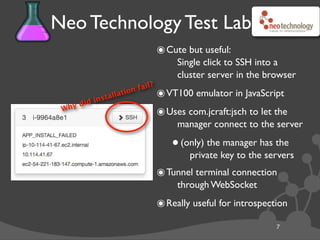

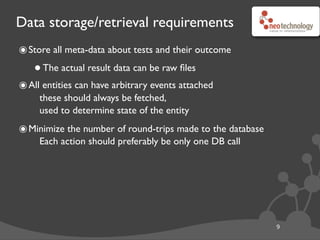

![An overview of Cypher
11
๏START - the node(s) your query starts from - Not needed in Neo4j 2.0
๏MATCH - the pattern to follow from the start point(s)
this expands your search space
๏WHERE - filter instances of the pattern
this reduces your search space
๏RETURN - create a result projection
of each matching instance of the pattern
๏Patterns are described using ASCII-art
•(me)-[:FRIEND]-()-[:FRIEND]-(my_foaf)
(me)-[:LIKES]->()<-[:LIKES]-(foaf)
// find friends of my friends that share an interest with me
The basics in one slide](https://image.slidesharecdn.com/buildingapplicationswithagraphdatabase-130927150303-phpapp02/85/Building-Applications-with-a-Graph-Database-11-320.jpg)




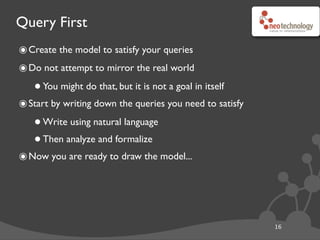
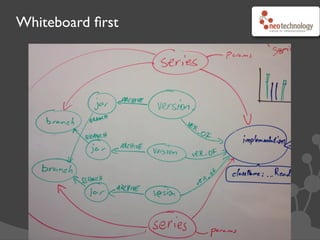

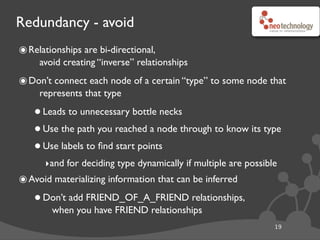

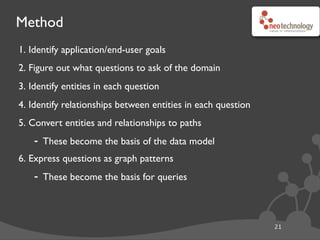





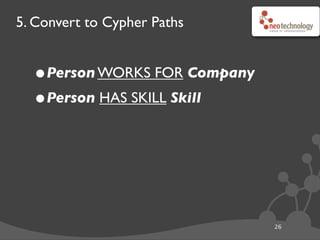

![5. Convert to Cypher Paths
26
•Person WORKS FOR Company
•Person HAS SKILL Skill
(:Person)-[:WORKS_FOR]->(:Company),
(:Person)-[:HAS_SKILL]->(:Skill)
Relationship
NodeNode Relationship
Node Node
Thanks to Ian Robinson](https://image.slidesharecdn.com/buildingapplicationswithagraphdatabase-130927150303-phpapp02/85/Building-Applications-with-a-Graph-Database-29-320.jpg)
![5. Convert to Cypher Paths
26
•Person WORKS FOR Company
•Person HAS SKILL Skill
(:Person)-[:WORKS_FOR]->(:Company),
(:Person)-[:HAS_SKILL]->(:Skill)
Relationship
NodeNode Relationship
Node Node
Label Label
Label Label
Thanks to Ian Robinson](https://image.slidesharecdn.com/buildingapplicationswithagraphdatabase-130927150303-phpapp02/85/Building-Applications-with-a-Graph-Database-30-320.jpg)
![5. Convert to Cypher Paths
26
•Person WORKS FOR Company
•Person HAS SKILL Skill
(:Person)-[:WORKS_FOR]->(:Company),
(:Person)-[:HAS_SKILL]->(:Skill)
Relationship
NodeNode Relationship
Node Node
Label Label
Label Label
Relationship Type
Relationship Type
Thanks to Ian Robinson](https://image.slidesharecdn.com/buildingapplicationswithagraphdatabase-130927150303-phpapp02/85/Building-Applications-with-a-Graph-Database-31-320.jpg)
![Consolidate Pattern
(:Person)-[:WORKS_FOR]->(:Company),
(:Person)-[:HAS_SKILL]->(:Skill)
(:Company)<-[:WORKS_FOR]-(:Person)-[:HAS_SKILL]->(:Skill)
27
Person SkillCompany
WORKS_FOR HAS_SKILL
Thanks to Ian Robinson](https://image.slidesharecdn.com/buildingapplicationswithagraphdatabase-130927150303-phpapp02/85/Building-Applications-with-a-Graph-Database-32-320.jpg)
![Candidate Data Model
(:Company)<-[:WORKS_FOR]-(:Person)-[:HAS_SKILL]->(:Skill)
28
name:
Neo4j
name:
Ian
name:
ACME
Person
Company
WORKS_FOR
HAS_SKILL
name:
Jacob
Person
name:
Tobias
Person
W
O
RKS_FO
R W
O
RKS_FO
R
name:
Scala
name:
Python
name:
C#
SkillSkillSkillSkill
HAS_SKILL
HAS_SKILLHAS_SKILL
HAS_SKILL
HAS_SKILL
HAS_SKILL
Thanks to Ian Robinson](https://image.slidesharecdn.com/buildingapplicationswithagraphdatabase-130927150303-phpapp02/85/Building-Applications-with-a-Graph-Database-33-320.jpg)

![Cypher Query
Which people, who work for the same
company as me, have similar skills to me?
MATCH (company)<-[:WORKS_FOR]-(me:Person)-[:HAS_SKILL]->(skill)
(company)<-[:WORKS_FOR]-(colleague)-[:HAS_SKILL]->(skill)
WHERE me.name = {name}
RETURN colleague.name AS name,
count(skill) AS score,
collect(skill.name) AS skills
ORDER BY score DESC
30
skill
company
Company
colleagueme
Person
W
O
RKS_FO
R
W
O
RKS_FO
R
Skill
HAS_SKILL HAS_SKILL
Person
Thanks to Ian Robinson](https://image.slidesharecdn.com/buildingapplicationswithagraphdatabase-130927150303-phpapp02/85/Building-Applications-with-a-Graph-Database-35-320.jpg)
![Cypher Query
Which people, who work for the same
company as me, have similar skills to me?
MATCH (company)<-[:WORKS_FOR]-(me:Person)-[:HAS_SKILL]->(skill)
(company)<-[:WORKS_FOR]-(colleague)-[:HAS_SKILL]->(skill)
WHERE me.name = {name}
RETURN colleague.name AS name,
count(skill) AS score,
collect(skill.name) AS skills
ORDER BY score DESC
31
skill
company
Company
colleagueme
Person
W
O
RKS_FO
R
W
O
RKS_FO
R
Skill
HAS_SKILL HAS_SKILL
Person
1. Graph pattern](https://image.slidesharecdn.com/buildingapplicationswithagraphdatabase-130927150303-phpapp02/85/Building-Applications-with-a-Graph-Database-36-320.jpg)
![Cypher Query
Which people, who work for the same
company as me, have similar skills to me?
MATCH (company)<-[:WORKS_FOR]-(me:Person)-[:HAS_SKILL]->(skill)
(company)<-[:WORKS_FOR]-(colleague)-[:HAS_SKILL]->(skill)
WHERE me.name = {name}
RETURN colleague.name AS name,
count(skill) AS score,
collect(skill.name) AS skills
ORDER BY score DESC
32
skill
company
Company
colleagueme
Person
W
O
RKS_FO
R
W
O
RKS_FO
R
Skill
HAS_SKILL HAS_SKILL
Person
1. Graph pattern
2. Filter, using index if available](https://image.slidesharecdn.com/buildingapplicationswithagraphdatabase-130927150303-phpapp02/85/Building-Applications-with-a-Graph-Database-37-320.jpg)
![Cypher Query
Which people, who work for the same
company as me, have similar skills to me?
MATCH (company)<-[:WORKS_FOR]-(me:Person)-[:HAS_SKILL]->(skill)
(company)<-[:WORKS_FOR]-(colleague)-[:HAS_SKILL]->(skill)
WHERE me.name = {name}
RETURN colleague.name AS name,
count(skill) AS score,
collect(skill.name) AS skills
ORDER BY score DESC
33
skill
company
Company
colleagueme
Person
W
O
RKS_FO
R
W
O
RKS_FO
R
Skill
HAS_SKILL HAS_SKILL
Person
1. Graph pattern
2. Filter, using index if available
3. Create projection of result](https://image.slidesharecdn.com/buildingapplicationswithagraphdatabase-130927150303-phpapp02/85/Building-Applications-with-a-Graph-Database-38-320.jpg)



![Result of the Query
+-------------------------------------+
| name | score | skills |
+-------------------------------------+
| "Ian" | 2 | ["Scala","Neo4j"] |
| "Jacob" | 1 | ["Neo4j"] |
+-------------------------------------+
2 rows
37
Thanks to Ian Robinson](https://image.slidesharecdn.com/buildingapplicationswithagraphdatabase-130927150303-phpapp02/85/Building-Applications-with-a-Graph-Database-42-320.jpg)





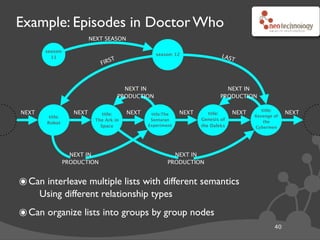
![Add to list
42
MATCH (test:Test{testId:{testId}})
MERGE (recents:Recent{type:"Test"})
CREATE (recents)-[:LAST_COMPLETED_TEST]->(test)
WITH recents, test
MATCH (recents)-[:LAST_COMPLETED_TEST]-> (test),
(previousTest)<-[previous:LAST_COMPLETED_TEST]-(recents)
DELETE previous
CREATE (test)-[:PREVIOUS_COMPLETED_TEST]->(previousTest)](https://image.slidesharecdn.com/buildingapplicationswithagraphdatabase-130927150303-phpapp02/85/Building-Applications-with-a-Graph-Database-49-320.jpg)
![Add to list
43
MATCH (test:Test{testId:{testId}})
MERGE (recents:Recent{type:"Test"})
CREATE (recents)-[:LAST_COMPLETED_TEST]->(test)
WITH recents, test
MATCH (recents)-[:LAST_COMPLETED_TEST]-> (test),
(previousTest)<-[previous:LAST_COMPLETED_TEST]-(recents)
DELETE previous
CREATE (test)-[:PREVIOUS_COMPLETED_TEST]->(previousTest)
// create the structure we want for the most recent one
MATCH (test:Test{testId:{testId}})
MERGE (recents:Recent{type:"Test"})
CREATE (recents)-[:LAST_COMPLETED_TEST]->(test)](https://image.slidesharecdn.com/buildingapplicationswithagraphdatabase-130927150303-phpapp02/85/Building-Applications-with-a-Graph-Database-50-320.jpg)
![Add to list
44
// create the structure we want for the most recent one
MATCH (test:Test{testId:{testId}})
MERGE (recents:Recent{type:"Test"})
CREATE (recents)-[:LAST_COMPLETED_TEST]->(test)
WITH recents, test
MATCH (recents)-[:LAST_COMPLETED_TEST]-> (test),
(previousTest)<-[previous:LAST_COMPLETED_TEST]-(recents)
DELETE previous
CREATE (test)-[:PREVIOUS_COMPLETED_TEST]->(previousTest)
// start a new sub-query, carrying through ‘recents’ and ‘test’
WITH recents, test](https://image.slidesharecdn.com/buildingapplicationswithagraphdatabase-130927150303-phpapp02/85/Building-Applications-with-a-Graph-Database-51-320.jpg)
![Add to list
45
// create the structure we want for the most recent one
MATCH (test:Test{testId:{testId}})
MERGE (recents:Recent{type:"Test"})
CREATE (recents)-[:LAST_COMPLETED_TEST]->(test)
// start a new sub-query, carrying through ‘recents’ and ‘test’
WITH recents, test
MATCH (recents)-[:LAST_COMPLETED_TEST]-> (test),
(previousTest)<-[previous:LAST_COMPLETED_TEST]-(recents)
DELETE previous
CREATE (test)-[:PREVIOUS_COMPLETED_TEST]->(previousTest)
// matching the relationship we just created...
MATCH (recents)-[:LAST_COMPLETED_TEST]-> (test),
// ...ensures that ‘previous’ is a different relationship
(previousTest)<-[previous:LAST_COMPLETED_TEST]-(recents)
// if there was no previous, this sub-query will match nothing](https://image.slidesharecdn.com/buildingapplicationswithagraphdatabase-130927150303-phpapp02/85/Building-Applications-with-a-Graph-Database-52-320.jpg)
![Add to list
46
// create the structure we want for the most recent one
MATCH (test:Test{testId:{testId}})
MERGE (recents:Recent{type:"Test"})
CREATE (recents)-[:LAST_COMPLETED_TEST]->(test)
// start a new sub-query, carrying through ‘recents’ and ‘test’
WITH recents, test
// matching the relationship we just created...
MATCH (recents)-[:LAST_COMPLETED_TEST]-> (test),
// ...ensures that ‘previous’ is a different relationship
(previousTest)<-[previous:LAST_COMPLETED_TEST]-(recents)
// if there was no previous, this sub-query will match nothing
DELETE previous
CREATE (test)-[:PREVIOUS_COMPLETED_TEST]->(previousTest)
// re-link to the previousTest
DELETE previous
CREATE (test)-[:PREVIOUS_COMPLETED_TEST]->(previousTest)](https://image.slidesharecdn.com/buildingapplicationswithagraphdatabase-130927150303-phpapp02/85/Building-Applications-with-a-Graph-Database-53-320.jpg)
![Add to list
47
// create the structure we want for the most recent one
MATCH (test:Test{testId:{testId}})
MERGE (recents:Recent{type:"Test"})
CREATE (recents)-[:LAST_COMPLETED_TEST]->(test)
// start a new sub-query, carrying through ‘recents’ and ‘test’
WITH recents, test
// matching the relationship we just created...
MATCH (recents)-[:LAST_COMPLETED_TEST]-> (test),
// ...ensures that ‘previous’ is a different relationship
(previousTest)<-[previous:LAST_COMPLETED_TEST]-(recents)
// if there was no previous, this sub-query will match nothing
// re-link to the previousTest
DELETE previous
CREATE (test)-[:PREVIOUS_COMPLETED_TEST]->(previousTest)](https://image.slidesharecdn.com/buildingapplicationswithagraphdatabase-130927150303-phpapp02/85/Building-Applications-with-a-Graph-Database-54-320.jpg)
![Get 5 most recently completed tests
MATCH (recents:Recent{type:"Test"}),
(recents)-[:LAST_COMPLETED_TEST]->(last)
tests=(last)-[:PREVIOUS_COMPLETED_TEST*0..5]->()
WITH tests ORDER BY length(tests) DESC LIMIT 1
RETURN extract(test IN nodes(tests) : test.testId) AS testIds
48](https://image.slidesharecdn.com/buildingapplicationswithagraphdatabase-130927150303-phpapp02/85/Building-Applications-with-a-Graph-Database-55-320.jpg)
![Get 5 most recently completed tests
MATCH (recents:Recent{type:"Test"}),
(recents)-[:LAST_COMPLETED_TEST]->(last)
tests=(last)-[:PREVIOUS_COMPLETED_TEST*0..5]->()
WITH tests ORDER BY length(tests) DESC LIMIT 1
RETURN extract(test IN nodes(tests) : test.testId) AS testIds
48
Get the next page of 5
MATCH (last:Test{testId={testId}})
tests=(last)-[:PREVIOUS_COMPLETED_TEST*0..5]->()
WITH tests ORDER BY length(tests) DESC LIMIT 1
RETURN extract(test IN nodes(tests) : test.testId) AS testIds](https://image.slidesharecdn.com/buildingapplicationswithagraphdatabase-130927150303-phpapp02/85/Building-Applications-with-a-Graph-Database-56-320.jpg)

![Adding and Removing from Active Set
50
// Create cluster into active set
MATCH (clusters:ActiveSet{type:"Cluster"}),
(creator:User{userId:{userId}})
CREATE (clusters)-[:CLUSTER]->(cluster:Cluster{
clusterId: {clusterId},
clusterType: {clusterType}
}),
(cluster)-[:CREATED]->(:Event{timestamp:{creationDate}})
<-[:ACTION]-(creator)
// Destroy cluster (remove it from the active set)
MATCH (cluster:Cluster{clusterId:{clusterId}})<-[r:CLUSTER]-(),
(destroyer:User{userId:{userId}})
CREATE (cluster)-[:DESTROYED]->(:Event{timestamp:{destroyDate}})
<-[:ACTION]-(destroyer)
DELETE r](https://image.slidesharecdn.com/buildingapplicationswithagraphdatabase-130927150303-phpapp02/85/Building-Applications-with-a-Graph-Database-58-320.jpg)




![Find all active clusters - Neo4j 2.0
MATCH (clusters:ActiveSet{type:"Cluster"})
(clusters)-[:CLUSTER]->(cluster),
(server)-[?:MEMBER_OF]->(cluster),
(server)-[e]->(event:Event),
(event)-[?]->(details)
WITH cluster, server, e, event, collect(details) as eventDetails
WITH cluster, server,
collect({ type: type(e),
data: event,
details: eventDetails }) as serverEvents
WITH cluster, collect({ server: server,
events: serverEvents }) as servers
MATCH (cluster)-[?:PARAMETERS]->(parameters),
(cluster)-[e]->(event:Event)<-[:ACTION]-(actor)
RETURN cluster, serverNodeIds, parameters,
collect({ type: type(e),
data: event,
actor: actor} ) as events 55](https://image.slidesharecdn.com/buildingapplicationswithagraphdatabase-130927150303-phpapp02/85/Building-Applications-with-a-Graph-Database-63-320.jpg)
![Find all active clusters - Neo4j 2.0
MATCH (clusters:ActiveSet{type:"Cluster"})
(clusters)-[:CLUSTER]->(cluster),
(server)-[?:MEMBER_OF]->(cluster),
(server)-[e]->(event:Event),
(event)-[?]->(details)
WITH cluster, server, e, event, collect(details) as eventDetails
WITH cluster, server,
collect({ type: type(e),
data: event,
details: eventDetails }) as serverEvents
WITH cluster, collect({ server: server,
events: serverEvents }) as servers
MATCH (cluster)-[?:PARAMETERS]->(parameters),
(cluster)-[e]->(event:Event)<-[:ACTION]-(actor)
RETURN cluster, serverNodeIds, parameters,
collect({ type: type(e),
data: event,
actor: actor} ) as events 56
MATCH (clusters:ActiveSet{type:"Cluster"})
(clusters)-[:CLUSTER]->(cluster), // each active cluster](https://image.slidesharecdn.com/buildingapplicationswithagraphdatabase-130927150303-phpapp02/85/Building-Applications-with-a-Graph-Database-64-320.jpg)
![Find all active clusters - Neo4j 2.0
MATCH (clusters:ActiveSet{type:"Cluster"})
(clusters)-[:CLUSTER]->(cluster),
(server)-[?:MEMBER_OF]->(cluster),
(server)-[e]->(event:Event),
(event)-[?]->(details)
WITH cluster, server, e, event, collect(details) as eventDetails
WITH cluster, server,
collect({ type: type(e),
data: event,
details: eventDetails }) as serverEvents
WITH cluster, collect({ server: server,
events: serverEvents }) as servers
MATCH (cluster)-[?:PARAMETERS]->(parameters),
(cluster)-[e]->(event:Event)<-[:ACTION]-(actor)
RETURN cluster, serverNodeIds, parameters,
collect({ type: type(e),
data: event,
actor: actor} ) as events 57
(server)-[?:MEMBER_OF]->(cluster),// 0 or more servers
(server)-[e]->(event:Event),// any relationship to an Event
(event)-[?]->(details)// 0 or more details](https://image.slidesharecdn.com/buildingapplicationswithagraphdatabase-130927150303-phpapp02/85/Building-Applications-with-a-Graph-Database-65-320.jpg)
![Find all active clusters - Neo4j 2.0
MATCH (clusters:ActiveSet{type:"Cluster"})
(clusters)-[:CLUSTER]->(cluster),
(server)-[?:MEMBER_OF]->(cluster),
(server)-[e]->(event:Event),
(event)-[?]->(details)
WITH cluster, server, e, event, collect(details) as eventDetails
WITH cluster, server,
collect({ type: type(e),
data: event,
details: eventDetails }) as serverEvents
WITH cluster, collect({ server: server,
events: serverEvents }) as servers
MATCH (cluster)-[?:PARAMETERS]->(parameters),
(cluster)-[e]->(event:Event)<-[:ACTION]-(actor)
RETURN cluster, serverNodeIds, parameters,
collect({ type: type(e),
data: event,
actor: actor} ) as events 58
// group by (cluster, server, e, event)
WITH cluster, server, e, event, collect(details) as eventDetails
// A second WITH to do collect-of-collect
WITH cluster, server, // group by (cluster, server)
collect({ type: type(e),
data: event,
details: eventDetails }) as serverEvents](https://image.slidesharecdn.com/buildingapplicationswithagraphdatabase-130927150303-phpapp02/85/Building-Applications-with-a-Graph-Database-66-320.jpg)
![Find all active clusters - Neo4j 2.0
MATCH (clusters:ActiveSet{type:"Cluster"})
(clusters)-[:CLUSTER]->(cluster),
(server)-[?:MEMBER_OF]->(cluster),
(server)-[e]->(event:Event),
(event)-[?]->(details)
WITH cluster, server, e, event, collect(details) as eventDetails
WITH cluster, server,
collect({ type: type(e),
data: event,
details: eventDetails }) as serverEvents
WITH cluster, collect({ server: server,
events: serverEvents }) as servers
MATCH (cluster)-[?:PARAMETERS]->(parameters),
(cluster)-[e]->(event:Event)<-[:ACTION]-(actor)
RETURN cluster, serverNodeIds, parameters,
collect({ type: type(e),
data: event,
actor: actor} ) as events 59
// Group the servers (with events) for each cluster
WITH cluster, collect({ server: server,
events: serverEvents }) as servers](https://image.slidesharecdn.com/buildingapplicationswithagraphdatabase-130927150303-phpapp02/85/Building-Applications-with-a-Graph-Database-67-320.jpg)
![Find all active clusters - Neo4j 2.0
MATCH (clusters:ActiveSet{type:"Cluster"})
(clusters)-[:CLUSTER]->(cluster),
(server)-[?:MEMBER_OF]->(cluster),
(server)-[e]->(event:Event),
(event)-[?]->(details)
WITH cluster, server, e, event, collect(details) as eventDetails
WITH cluster, server,
collect({ type: type(e),
data: event,
details: eventDetails }) as serverEvents
WITH cluster, collect({ server: server,
events: serverEvents }) as servers
MATCH (cluster)-[?:PARAMETERS]->(parameters),
(cluster)-[e]->(event:Event)<-[:ACTION]-(actor)
RETURN cluster, serverNodeIds, parameters,
collect({ type: type(e),
data: event,
actor: actor} ) as events 60
MATCH (cluster)-[?:PARAMETERS]->(parameters),
// Find all events for this cluster
(cluster)-[e]->(event:Event)<-[:ACTION]-(actor)](https://image.slidesharecdn.com/buildingapplicationswithagraphdatabase-130927150303-phpapp02/85/Building-Applications-with-a-Graph-Database-68-320.jpg)
![Find all active clusters - Neo4j 2.0
MATCH (clusters:ActiveSet{type:"Cluster"})
(clusters)-[:CLUSTER]->(cluster),
(server)-[?:MEMBER_OF]->(cluster),
(server)-[e]->(event:Event),
(event)-[?]->(details)
WITH cluster, server, e, event, collect(details) as eventDetails
WITH cluster, server,
collect({ type: type(e),
data: event,
details: eventDetails }) as serverEvents
WITH cluster, collect({ server: server,
events: serverEvents }) as servers
MATCH (cluster)-[?:PARAMETERS]->(parameters),
(cluster)-[e]->(event:Event)<-[:ACTION]-(actor)
RETURN cluster, serverNodeIds, parameters,
collect({ type: type(e),
data: event,
actor: actor} ) as events 61
RETURN cluster, serverNodeIds, parameters,
// Collect the events in three (aligned) collections
collect({ type: type(e),
data: event,
actor: actor} ) as events](https://image.slidesharecdn.com/buildingapplicationswithagraphdatabase-130927150303-phpapp02/85/Building-Applications-with-a-Graph-Database-69-320.jpg)
![Find all active clusters - Neo4j 2.0
62
MATCH (clusters:ActiveSet{type:"Cluster"})
(clusters)-[:CLUSTER]->(cluster), // each active cluster
(server)-[?:MEMBER_OF]->(cluster),// 0 or more servers
(server)-[e]->(event:Event),// any relationship to an Event
(event)-[?]->(details)// 0 or more details
// group by (cluster, server, e, event)
WITH cluster, server, e, event, collect(details) as eventDetails
// A second WITH to do collect-of-collect
WITH cluster, server, // group by (cluster, server)
collect({ type: type(e),
data: event,
details: eventDetails }) as serverEvents
// Group the servers (with events) for each cluster
WITH cluster, collect({ server: server,
events: serverEvents }) as servers
MATCH (cluster)-[?:PARAMETERS]->(parameters),
// Find all events for this cluster
(cluster)-[e]->(event:Event)<-[:ACTION]-(actor)
RETURN cluster, serverNodeIds, parameters,
// Collect the events in three (aligned) collections
collect({ type: type(e),
data: event,
actor: actor} ) as events](https://image.slidesharecdn.com/buildingapplicationswithagraphdatabase-130927150303-phpapp02/85/Building-Applications-with-a-Graph-Database-70-320.jpg)
![Get Cluster by ID - Neo4j 2.0
(server)-[?:MEMBER_OF]->(cluster),// 0 or more servers
(server)-[e]->(event:Event),// any relationship to an Event
(event)-[?]->(details)// 0 or more details
// group by (cluster, server, e, event)
WITH cluster, server, e, event, collect(details) as eventDetails
// A second WITH to do collect-of-collect
WITH cluster, server, // group by (cluster, server)
collect({ type: type(e),
data: event,
details: eventDetails }) as serverEvents
// Group the servers (with events) for each cluster
WITH cluster, collect({ server: server,
events: serverEvents }) as servers
MATCH (cluster)-[?:PARAMETERS]->(parameters),
// Find all events for this cluster
(cluster)-[e]->(event:Event)<-[:ACTION]-(actor)
RETURN cluster, serverNodeIds, parameters,
// Collect the events in three (aligned) collections
collect({ type: type(e),
data: event,
actor: actor} ) as events 63
MATCH (cluster{type:{clusterId}}) // match single cluster by ID](https://image.slidesharecdn.com/buildingapplicationswithagraphdatabase-130927150303-phpapp02/85/Building-Applications-with-a-Graph-Database-71-320.jpg)










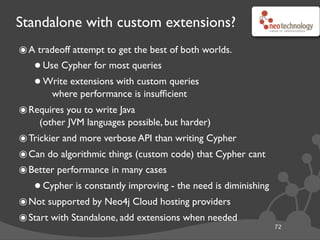


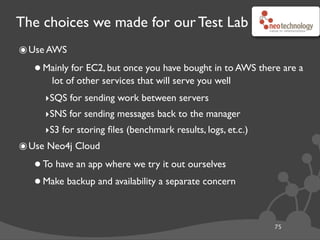






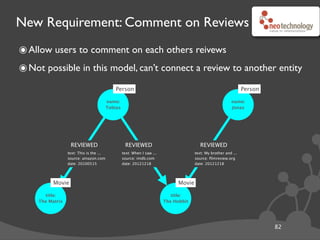




![Convert a Property to a Node
// find nodes that have the currency property
MATCH (t:Trade) WHERE has(t.currency)
// limit the size of the transaction
WITH t LIMIT {batchSize}
// find or create the (unique) node for this currency
MERGE (c:Currency{code:t.currency})
// create relationship to the currency node
CREATE (t)-[:CURRENCY]->(c)
// remove the property
REMOVE t.currency
// when the returned count is smaller then batchSize,
// you are done
RETURN count(t) AS numberRemoved
87
Thanks to Ian Robinson](https://image.slidesharecdn.com/buildingapplicationswithagraphdatabase-130927150303-phpapp02/85/Building-Applications-with-a-Graph-Database-97-320.jpg)
![Convert a Relationship to a Node
// find emailed relationships
MATCH (a:User)-[r:EMAILED]->(b:User)
// limit the size of each transaction
WITH a, r, b LIMIT {batchSize}
// create a new node and relationships for it
CREATE (a)<-[:FROM]-(:Email{
content: r.content,
title: t.title
}) -[:TO]-> (b)
// delete the old relationship
DELETE r
// when the returned count is smaller then batchSize,
// you are done
RETURN count(r) AS numberDeleted
88
Thanks to Ian Robinson](https://image.slidesharecdn.com/buildingapplicationswithagraphdatabase-130927150303-phpapp02/85/Building-Applications-with-a-Graph-Database-98-320.jpg)
